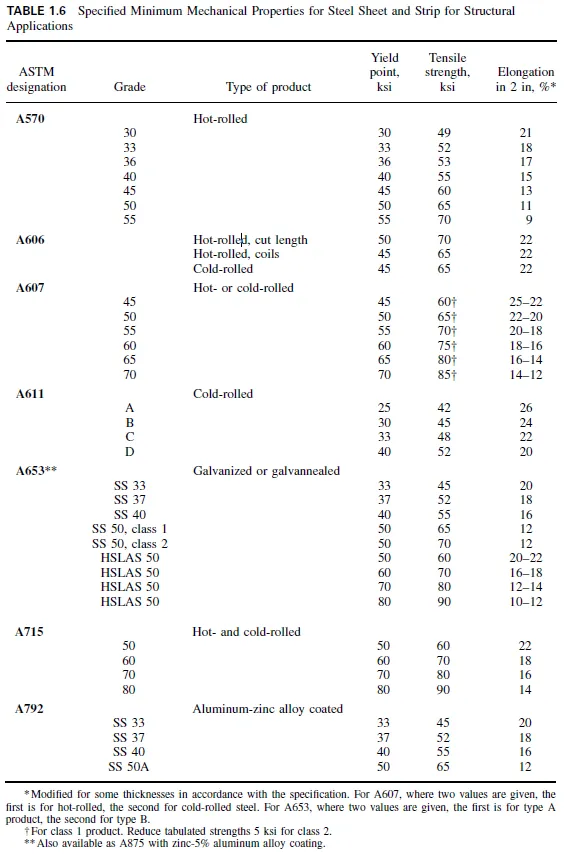Steel sheet and strip are used for many structural applications, including cold-formed members in building construction and the stressed skin of transportation equipment. Mechanical properties of several of the more frequently used sheet steels are presented in Table 1.6.
ASTM A570 covers seven strength grades of uncoated, hot-rolled, carbon-steel sheets
and strip intended for structural use.
A606 covers high-strength, low-alloy, hot- and cold-rolled steel sheet and strip with enhanced corrosion resistance. This material is intended for structural or miscellaneous uses where weight savings or high durability are important. It is available, in cut lengths or coils, in either type 2 or type 4, with atmospheric corrosion resistance approximately two or four times, respectively, that of plain carbon steel.
A607, available in six strength levels, covers high-strength, low-alloy columbium or vanadium, or both, hot- and cold-rolled steel sheet and strip. The material may be in either cut lengths or coils. It is intended for structural or miscellaneous uses where greater strength and weight savings are important. A607 is available in two classes, each with six similar strength levels, but class 2 offers better formability and weldability than class 1. Without addition of copper, these steels are equivalent in resistance to atmospheric corrosion to plain carbon steel. With copper, however, resistance is twice that of plain carbon steel.
A611 covers cold-rolled carbon sheet steel in coils and cut lengths. Four grades provide yield stress levels from 25 to 40 ksi. Also available is Grade E, which is a full-hard product with a minimum yield stress of 80 ksi but no specified minimum elongation.
A653 covers steel sheet, zinc coated (galvanized) or zinc-iron alloy coated (galvannealed) by the hot dip process in coils and cut lengths. Included are several grades of structural steel (SS) and high-strength low-alloy steel (HSLAS) with a yield stress of 33 to 80 ksi. HSLAS sheets are available as Type A, for applications where improved formability is important, and Type B for even better formability. The metallic coating is available in a wide range of coating weights, which provide excellent corrosion protection in many applications.
A715 provides for HSLAS, hot and cold-rolled, with improved formability over A606 an A607 steels. Yield stresses included range from 50 to 80 ksi.
A792 covers sheet in coils and cut lengths coated with aluminum-zinc alloy by the hot dip process. The coating is available in three coating weights, which provide both corrosion and heat resistance.




